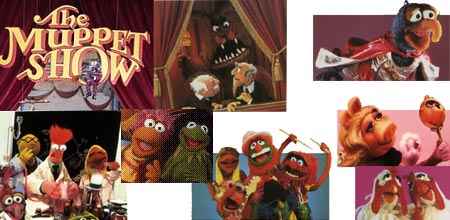The Muppet Show

Synopsis of TV Show
“It’s time to play the music,
It’s time to light the lights,
It’s time to meet the Muppets on The Muppet Show tonight…”
Jim Henson, architect of the Muppet empire, coined the term “muppet” around the time he was working on Sam and Friends, a televised puppet show he created in 1955 with his wife, Jane Nebel. The term was a combination of the words ‘marionette’ and ‘puppet,’ an accurate description of Henson’s unique, life-like creations. Henson’s Muppets soon became television staples, popping up almost constantly on talk shows and variety programs like The Ed Sullivan Show, The Jimmy Dean Show, Perry Como, and The Tonight Show. The success of the Muppets became even more impressive when they got a regular showcase on the acclaimed PBS series Sesame Street.
Boosted by his TV success, Henson wanted his creations to cross over to a prime time audience, but the major networks had already given the Muppets a “for kiddies only” branding. Henson had the last laugh when he took his Muppet staff to England, where he had set up a deal with English entrepreneur Sir Lew Grade to finance The Muppet Show. Not only did it become the most popular first-run syndicated series in television history, it also became the most widely seen television show of the late seventies. It is estimated that The Muppet Show has been seen by over 235 million people in at least 100 countries.
The Muppet Show utilized a variety format as a vehicle for its inspired and often surreal comedy. Each week, a new guest star would appear, and host Kermit the Frog would try to keep his vast array of animal, monster and mutant co-stars in check as they proceeded to turn each production number on the show into a complete and utter shambles. The Muppet Show quickly became the hip place for a celeb to have a widely-seen cameo, and the diverse list of guest stars included Elton John, Peter Sellers, Rudolf Nureyev, Zero Mostel, Steve Martin and Alice Cooper.
By the end of the 70’s, there were over 400 different Muppets, but the perennial favorites included egotistical starlet Miss Piggy (“Moi?”), frustrated trumpet-player and avowed chicken lover Gonzo, would-be comedian Fozzie Bear (“Wocka Wocka!”), the incomprehensible Swedish Chef, and piano player Rowlf. Other favorites included the quietly insane Dr. Bunsen Honeydew, his perpetually terrorized assistant Beaker, fiercely patriotic Sam the Eagle, kindly stage manager Scooter, fish thrower Lew Zealand, mad bomber Crazy Harry, gargantuan monster Sweetums, the stars of the sci-fi show-within-a-show “Pigs in Space,” and the house band, Dr. Teeth and the Electric Mayhem. Said band featured burnt-out guitarist Floyd and whacked-out drummer Animal. Watching (and heckling) the show from a nearby balcony were everybody’s favorite pair of old geezers, Statler and Waldorf.
The success of the show proved that Henson’s belief in the Muppets' crossover potential was on the money. Adults appreciated the bizarre-but-intelligent gags, and children adored the show’s visually inventive slapstick. However, the unifying factor for viewers of every age was that the Muppets seemed genuinely real. The puppeteers and voice-artists not only made these felt and foam-rubber creations appear funny and entertaining, they also gave them a realistic, human-like warmth that helped the viewers identify with the Muppets and take them to heart.
By the time The Muppet Show ended its first run in 1981, Henson had already introduced movie viewers to his creations via The Muppet Movie. More films, such as The Great Muppet Caper and The Muppets Take Manhattan, would be produced in later years, as well as new Henson television series like Fraggle Rock and the animated Muppet Babies. Jim Henson died of pneumonia in 1990, but the Muppets and their Muppet masters are still active today, producing a wide array of television programming and feature films.
“It’s time to get things started,
On the most sensational, inspirational, celebrational, Muppetational,
This is what we call The Muppet Show!”
Release History of Prime Time Show
1976 - 1981 SyndicatedTV Sub Categories
comedyTelevision Network
SyndicationTelevision Studio
Henson AssociatesTV Cast
Kermit the Frog Jim HensonRowlf Jim Henson
Link Hogthrob Jim Henson
The Swedish Chef (puppeteering and voice) Jim Henson
Dr. Teeth Jim Henson
Muppet Newsman Jim Henson
Waldorf Jim Henson
Animal Frank Oz
Fozzie Bear Frank Oz
Miss Piggy Frank Oz
Sam the Eagle Frank Oz
The Swedish Chef (Hands) Frank Oz
Beauregard Dave Goelz
The Great Gonzo Dave Goelz
Dr. Bunsen Honeydew Dave Goelz
Muppy Dave Goelz
Zoot Dave Goelz
Beaker Richard Hunt
Miss Piggy (1976-77) Richard Hunt
Janice Richard Hunt
Wayne Richard Hunt
Scooter Richard Hunt
Statler Richard Hunt
Sweetums Richard Hunt
Camilla Jerry Nelson
Sgt. Floyd Pepper Jerry Nelson
Robin the Frog Jerry Nelson
Crazy Harry (1977-81) Jerry Nelson
Uncle Deadly Jerry Nelson
Dr. Julius Strangepork Jerry Nelson
Pops (1979-81) Jerry Nelson
J.P. Grosse Jerry Nelson
Thog Jerry Nelson
Lew Zealand Jerry Nelson
Fleet Scribbler Jerry Nelson
Vend-a-Face (1976-77) Jerry Nelson
Announcer Jerry Nelson
Foo-Foo Steve Whitmire
Rizzo the Rat Steve Whitmire
Lips Steve Whitmire
Annie Sue Pig (1977-81) Louise Gold
Janice (1976-77) Eren Ozker
Wanda Eren Ozker
Hilda Eren Ozker
Crazy Harry (1976-77) John Lovelady
Nigel John Lovelady
